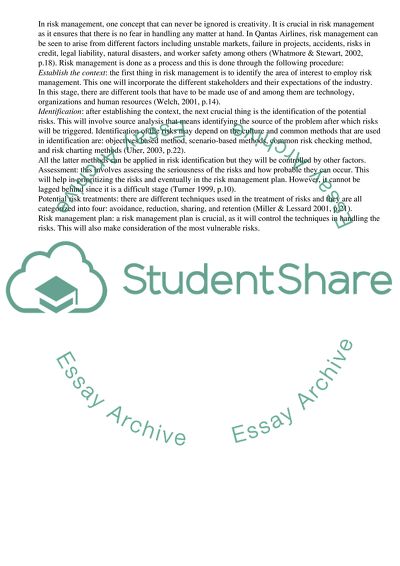Cite this document
(Qantas Airlines Risk Management Research Paper Example | Topics and Well Written Essays - 2750 words, n.d.)
Qantas Airlines Risk Management Research Paper Example | Topics and Well Written Essays - 2750 words. Retrieved from https://studentshare.org/management/1770179-this-assessment-requires-students-to-undertake-research-investigation-and-develop-a-research-proposal-in-response-to-a-one-business-related-problem-within-the-tourism-or-service-industries-the-choosen-industry-is-qantas-ariline
Qantas Airlines Risk Management Research Paper Example | Topics and Well Written Essays - 2750 words. Retrieved from https://studentshare.org/management/1770179-this-assessment-requires-students-to-undertake-research-investigation-and-develop-a-research-proposal-in-response-to-a-one-business-related-problem-within-the-tourism-or-service-industries-the-choosen-industry-is-qantas-ariline
(Qantas Airlines Risk Management Research Paper Example | Topics and Well Written Essays - 2750 Words)
Qantas Airlines Risk Management Research Paper Example | Topics and Well Written Essays - 2750 Words. https://studentshare.org/management/1770179-this-assessment-requires-students-to-undertake-research-investigation-and-develop-a-research-proposal-in-response-to-a-one-business-related-problem-within-the-tourism-or-service-industries-the-choosen-industry-is-qantas-ariline.
Qantas Airlines Risk Management Research Paper Example | Topics and Well Written Essays - 2750 Words. https://studentshare.org/management/1770179-this-assessment-requires-students-to-undertake-research-investigation-and-develop-a-research-proposal-in-response-to-a-one-business-related-problem-within-the-tourism-or-service-industries-the-choosen-industry-is-qantas-ariline.
“Qantas Airlines Risk Management Research Paper Example | Topics and Well Written Essays - 2750 Words”, n.d. https://studentshare.org/management/1770179-this-assessment-requires-students-to-undertake-research-investigation-and-develop-a-research-proposal-in-response-to-a-one-business-related-problem-within-the-tourism-or-service-industries-the-choosen-industry-is-qantas-ariline.


